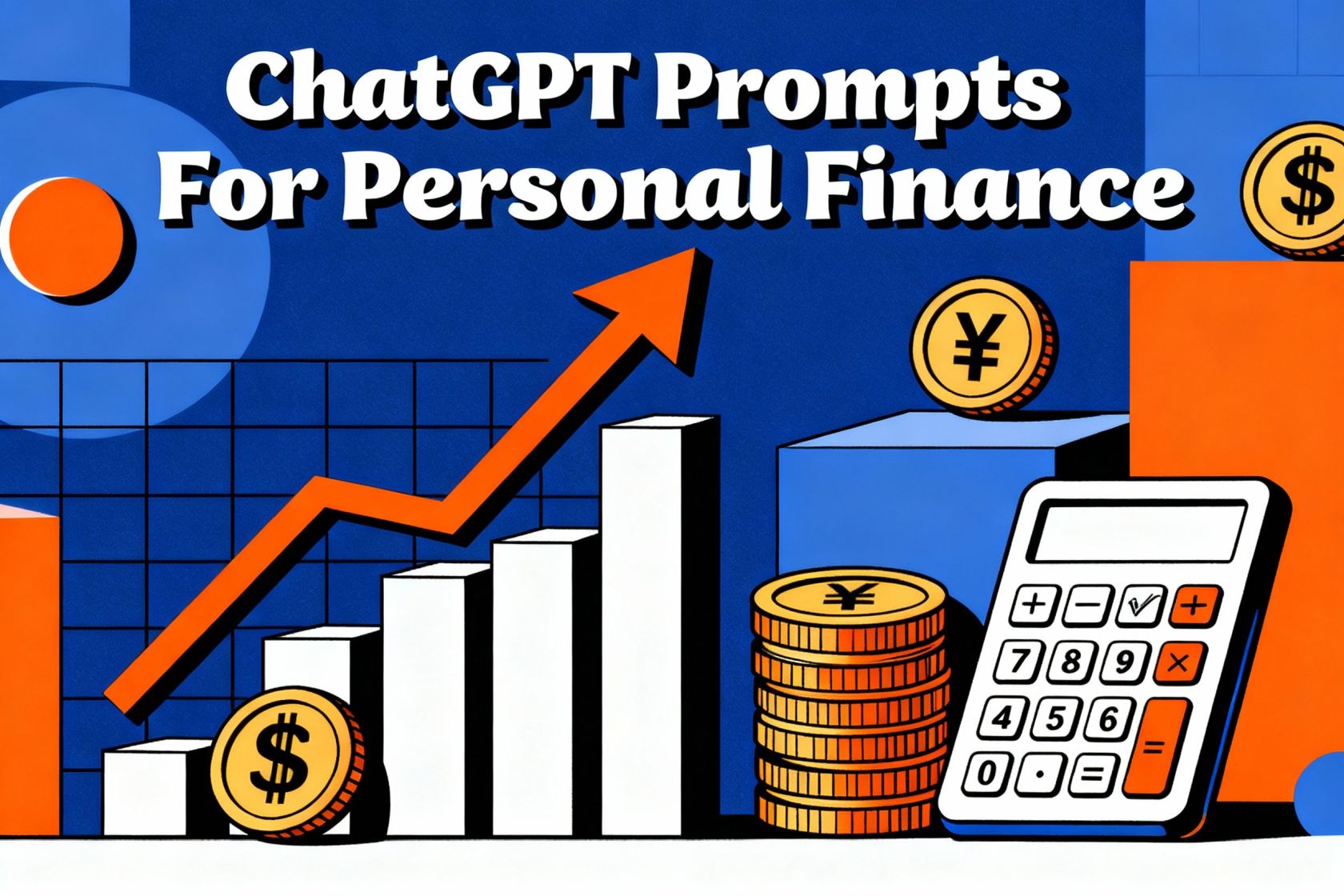Ever feel like your finances need a good debugging session?
Maybe your paycheck lands, but by the end of the month, half of it has vanished into some memory leak you can’t trace. You’re tired of juggling expenses and stressing over bills or that persistent credit card debt.
What if you had a cheat code for your money?
Here’s a great one, ChatGPT Prompts for Personal Finance can act as your smart assistant. It helps analyze spending patterns, create budgets in Google Sheets, and even forecast cash flows using simple mind-maps or csvs.
I’m going to walk you through 12 clear ways to boost savings, manage debts, cut costs, and plan for retirement. We’ll use the right prompts and tools, like index funds or public provident fund accounts, to get it done.
This post gives you straightforward steps to take control quickly, with less stress over the income tax return or rising interest rates. Ready to master your money? Let’s get started!
Key Takeaways
ChatGPT prompts can help automate budgeting and track spending in tools like Google Sheets or Mint, spotting budget leaks to save you hundreds each year.
Financial experts often recommend saving 40-50% of your income and building both an emergency fund (three to six months’ worth of expenses) and retirement accounts using diversified tools like ETFs and index funds.
Use the Debt Avalanche method to save money on high-interest debt by tackling the highest-rate debt first. Alternatively, the Debt Snowball offers quick psychological wins by clearing smaller balances. ChatGPT can model both scenarios for you.
Beginners can invest with as little as $10-$25 in low-cost ETFs or index funds, which often have expense ratios below 0.20%, offering much better value and diversified exposure compared to actively managed mutual funds that can charge over 1%.
Earning extra income from freelance gigs on platforms like Upwork or selling items online has tax implications. For 2025, you’ll receive a Form 1099-K for sales over $20,000 and more than 200 transactions, so it’s crucial to track your earnings.
Table of Contents
Budgeting and Saving Strategies

Think of every dollar as a packet of data, it needs a destination. The right plan turns chaotic spending into predictable, positive cash flow.
Apps like Google Sheets or Mint are great for spotting small leaks before they sink your personal budget. For those who love a more hands-on approach, You Need A Budget (YNAB) is fantastic for giving every dollar a specific job.
How can I create a monthly budget based on my income and expenses?
A monthly budget is your script for tracking cash flow and making smart financial decisions. For geeks, precision is everything, whether you’re coding or managing money.
The key is to give the AI clean data. Before pasting your bank statement CSV into ChatGPT, open it in Google Sheets and remove any weird formatting or extra columns. This simple step prevents errors and gives you a much more accurate analysis.
Here’s a simple process to follow:
- List all sources of income, from your main job to freelance gigs or side hustles.
- Track every single expense. Use your bank’s export feature or a budgeting app to get the raw data.
- Categorize your spending using a framework like the 50/30/20 rule: 50% for needs (rent, groceries), 30% for wants (new gadgets, subscriptions), and 20% for savings and debt repayment.
- Review your budget monthly. Your spending will change, so your budget needs to be a living document, not a static file.
- Use a ChatGPT prompt like this to get quick insights: “Analyze this CSV of my monthly spending. Identify my top 3 spending categories and suggest two ways to cut costs in each.”
- Set specific savings goals, like building a new PC or setting up a home server, and allocate funds for them in your budget.
- Don’t forget to build an emergency fund. Even $500 set aside can prevent a small tech issue from becoming a major financial problem.
- Use a monthly interest calculator to see how much your savings could grow over time in different accounts.
I did this last year after realizing my “small” Amazon gadget orders during Black Friday added up to a shocking amount. It took an hour each month but easily saved me hundreds by catching things I’d completely forgotten about.
What are effective ways to cut costs and save a specific amount?
Once your budget is broken down, it’s time to hunt for savings. Think of it as optimization, finding inefficiencies in your financial code.
A great place to start is with food delivery. It’s a common budget leak. If you can cut back, you could save a significant amount each month. Then, you can tackle subscriptions.
Services like Rocket Money and Trim are designed to find and help you cancel subscriptions you no longer use, which can easily reclaim $30 or more per month.
“Here’s a prompt to try: ‘I spend $400/month on groceries and $250/month on food delivery. Create a 7-day meal plan based on recipes that are cheap and easy to make, using common ingredients to minimize waste.’“
Here are a few other ways to optimize your spending:
- Automate your savings. Set up an automatic transfer to your savings account for the day after you get paid.
- Negotiate your bills. Call your internet or mobile phone provider annually. A quick 15-minute call can often save you hundreds over the year.
- Use browser extensions. Tools like Rakuten for cash back or Capital One Shopping for coupon codes can automatically save you money on online purchases.
- Sell old tech. That collection of old phones and laptops in your closet? Sell them on Facebook Marketplace or a dedicated subreddit to give your emergency fund a quick boost.
How do I develop a savings plan to reach a financial goal?
Building a savings plan is like designing a system to achieve a specific outcome. You need a clear goal, a logical structure, and consistent execution.
Your first and most important goal should be an emergency fund. According to a recent study by Empower, 37% of Americans couldn’t afford an unexpected expense of over $400. An emergency fund is your firewall against life’s unexpected errors.
Here’s how to build your savings plan:
- Define your goal. Be specific. Is it a $3,000 emergency fund? A down payment for a house? Know the exact amount you need.
- Set a timeline. Break the total amount into monthly targets to make it feel achievable.
- Open a High-Yield Savings Account (HYSA). Don’t leave your emergency fund in a traditional savings account. As of October 2025, banks like Varo Bank are offering APYs as high as 5.00%, while the national average is just 0.40%. That’s a huge difference in earnings.
- Automate your contributions. This is the most critical step. Set up automatic transfers from your checking to your HYSA right after each payday.
- Track your progress. Use a simple spreadsheet or a budgeting app to watch your savings grow. Seeing the numbers go up is a great motivator.
- Look for ways to earn extra income if you want to reach your goal faster.
Why should I prioritize building an emergency fund alongside paying off debt?
Think of an emergency fund as your personal UPS (Uninterruptible Power Supply). When a surprise expense hits, like a car repair or a medical bill, it keeps your financial system running without a catastrophic failure that forces you deeper into debt.
Without that cash buffer, any unexpected cost is likely to end up on a credit card, which often comes with high interest rates. This negates the progress you’re making on paying down your existing debt.
Experts often suggest a two-pronged approach. While you’re aggressively paying down debt, you should also be building a starter emergency fund of at least $1,000. Once high-interest debt is gone, you can focus on growing that fund to cover three to six months of living expenses.
Parking this money in a high-yield savings account is crucial. With rates at some banks reaching over 4.50%, your emergency fund can actually grow while it sits there, waiting for a rainy day.
Debt Management Techniques

Managing debt is about choosing the right algorithm for your situation. Let’s look at the two main approaches to keep your credit cards and loans in check.
What is the smartest strategy to pay off debts quickly?
From a purely mathematical standpoint, the Debt Avalanche method is the smartest strategy. With this approach, you focus all your extra payments on the debt with the highest interest rate first, while making minimum payments on everything else.
This saves you the most money over time because you’re eliminating the most expensive debt first. With the average credit card interest rate hovering around 20%, this can make a significant difference.
However, personal finance isn’t just about math, it’s also about psychology. That’s where the Debt Snowball approach comes in. With this method, you pay off your smallest debts first, regardless of the interest rate. The quick wins from clearing small balances can provide powerful motivation to keep going.
No matter which method you choose, you need a solid monthly budget. You can use ChatGPT to create a custom plan. Just provide your income, expenses, and a list of your debts with their balances and interest rates.
How do the debt snowball and debt avalanche methods compare?
Some geeks love a purely data-driven approach. Others need those small, satisfying wins to stay motivated. Here’s a side-by-side comparison of the debt snowball and debt avalanche methods.
| Feature | Debt Snowball | Debt Avalanche |
|---|---|---|
| Main Idea | Pay off the smallest balance first, ignoring interest rates initially. | Pay off the debt with the highest interest rate first, ignoring the balance size. |
| Psychology | Provides quick, motivating wins. Each paid-off debt feels like leveling up. | Can feel slower as progress is measured in interest saved, not quick wins. |
| Interest Savings | Less efficient. You will likely pay more in total interest over time. | The most efficient method. Saves you the most money on interest. |
| Best For | People who need motivation and get a boost from seeing progress quickly. | People who are disciplined and motivated by optimizing the numbers. |
| Example | You’d pay off a $500 credit card first, even if your $5,000 car loan has a higher interest rate. | You’d tackle the $5,000 car loan first because its interest rate is costing you more. |
| Key Proponent | Popularized by personal finance personality Dave Ramsey. | Favored by most financial advisors for its mathematical efficiency. |
Not sure which one is right for you? ChatGPT can help. Give it a list of your debts, balances, and interest rates, and ask it to model both scenarios. It can show you the total interest paid and the time to freedom for each method, helping you make a data-driven decision that also fits your personality.
Investing and Retirement Planning

Investing is how you build long-term wealth. Understanding the basics of the stock market, retirement accounts, and low-cost funds is essential for your future self.
What are beginner-friendly investment options like ETFs and index funds?
Exchange-Traded Funds (ETFs) and index funds are perfect for beginners because they provide instant diversification. Instead of trying to pick individual winning stocks, you can buy a small piece of the entire market in a single transaction.
These funds track major financial indices, like the S&P 500. They don’t try to outperform the market, they aim to match its performance, which is a surprisingly effective strategy over the long term.
The best part is their incredibly low cost. Many ETFs and index funds have expense ratios below 0.20%. For example, the popular Vanguard S&P 500 ETF (VOO) has an expense ratio of just 0.03%. In contrast, some actively managed mutual funds can charge over 1%. That might not sound like much, but over decades, that difference can cost you tens of thousands of dollars in lost returns.
“Diversification is like running a RAID array for your portfolio. If one drive fails, your data is still safe. If one stock crashes, your portfolio remains stable.”
You don’t need a lot of money to start. Many brokerage platforms allow you to invest in ETFs and index funds with as little as $10 or $25.
How much should I realistically save for retirement and what strategies work?
As a geek, you appreciate a good benchmark. When it comes to retirement savings, a widely cited guideline comes from Fidelity, which suggests aiming to have 1x your salary saved by age 30, 3x by 40, 6x by 50, and 10x by 67.
Here are some key strategies to help you get there:
- Automate your investments. Set up automatic contributions to your retirement accounts from every paycheck. This “pay yourself first” approach is the most effective way to build wealth consistently.
- Max out your employer match. If your employer offers a 401(k) match, contribute at least enough to get the full amount. It’s free money.
- Open a Roth IRA. For 2025, you can contribute up to $7,000 (or $8,000 if you’re 50 or older) to a Roth IRA. Your money grows tax-free, and withdrawals in retirement are also tax-free.
- Use low-cost funds. Build your portfolio around broad-market ETFs and index funds to keep your costs down and your returns up.
- Don’t forget other options. The Public Provident Fund (PPF) and Equity Linked Savings Schemes (ELSS) can offer great tax benefits under Section 80C of the Income Tax Act.
- Review and rebalance annually. Once a year, check your asset allocation to ensure it still aligns with your goals and risk tolerance.
Every step you take tightens up your financial code and plugs potential leaks in your long-term plan.
What are the long-term benefits of investing in stocks versus real estate?
Both stocks and real estate can be powerful wealth-building tools, but they operate very differently. Stocks, particularly when held in diversified index funds, have historically provided strong returns. Over the long term, the stock market has averaged returns of around 7-10% annually.
One of the biggest advantages of stocks is liquidity. You can sell your shares and have cash in hand within a few days. You can’t do that with a house. Plus, the entry point is much lower, you don’t need a massive down payment to buy a few shares of an ETF.
Real estate, on the other hand, offers the benefit of rental income, which can provide a steady cash flow in retirement. It also comes with significant tax advantages, like deductions for mortgage interest and property taxes.
For geeks who don’t want the hassle of being a landlord but still want exposure to real estate, Real Estate Investment Trusts (REITs) are a great option. REITs are companies that own and operate income-producing real estate, and you can buy shares of them just like any other stock.
Financial Planning Approaches

Crunching numbers isn’t just for financial analysts. Anyone can map out a plan that fits their needs. Tracking your spending with tools like Mint or a simple spreadsheet can help you spot leaks in your wallet faster than you can say “Excel sheet.”
How can I create a plan to save for a house down payment?
Saving for a house down payment is a major project that requires a solid plan and a lot of focus. Here’s a step-by-step guide to get you there.
- Set a clear goal. Research the housing market in your desired area to determine a realistic down payment amount. With the median home sale price in the U.S. being around $410,800 in the second quarter of 2025, a 20% down payment is a substantial goal.
- Create a dedicated budget. Use a tool like Mint or YNAB to track every dollar and identify areas where you can cut back.
- Automate your savings. Open a separate high-yield savings account just for your down payment and set up automatic transfers for every payday.
- Look for ways to boost your income. This could be through freelance work, a side hustle, or negotiating a raise at your current job.
- Explore assistance programs. Don’t forget to look into options like FHA loans, which can have down payment requirements as low as 3.5% if you have a credit score of 580 or higher. There are also many state and local down payment assistance programs available.
- Ask ChatGPT for help. Use a prompt like: “My goal is to save a $60,000 down payment in 3 years. My current monthly savings rate is $800. Analyze my attached budget and provide 5 actionable strategies to increase my savings rate to reach my goal.”
What are some ways to earn extra income and their tax implications?
As a techie, you have a valuable skillset that can be monetized in many ways. But with great side hustles come great tax responsibilities.
Here are a few options and what you need to know about the taxes:
- Freelancing: Platforms like Upwork and Fiverr make it easy to find gigs. You’ll be considered self-employed, so you’ll need to pay self-employment taxes and will likely receive a 1099 form.
- Selling Digital Products: If you create and sell digital assets on a platform like Etsy, you’ll pay taxes on your profits after deducting business expenses.
- Monetizing a Blog or YouTube Channel: Revenue from ads or affiliate links is considered taxable income. Platforms like Google AdSense will issue a Form 1099-K.
- Reselling Tech Gadgets: If you sell items on eBay for more than you paid, that profit is considered a capital gain and is taxable.
A key thing to watch for is Form 1099-K. For the 2025 tax year, the reporting threshold has reverted to the original rule: you’ll receive one if you have over $20,000 in payments AND more than 200 transactions. Even if you don’t receive a form, you are still legally required to report all income to the IRS.
Using tax software like TurboTax Self-Employed or QuickBooks Self-Employed can make tracking income and expenses much easier.
How do I review my expenses to identify overspending areas?
Reviewing your expenses is like debugging your financial code. You need to go line by line to find the bugs that are causing leaks.
- Gather your data. Download the last three months of your bank and credit card statements. This gives you a solid dataset to work with.
- Import it into a spreadsheet. Use Google Sheets or Excel to easily sort and categorize your transactions.
- Categorize everything. Create categories like “Groceries,” “Dining Out,” “Subscriptions,” “Utilities,” and “Shopping.”
- Identify the big spenders. Sort by category totals to see where most of your money is going. This is often an eye-opening experience.
- Use ChatGPT to dig deeper. Paste your categorized data and use a prompt like: “This is my spending for the last 3 months. What are my 3 most volatile spending categories, and what patterns do you see? Suggest alerts I could set up to control them.”
- Check for recurring charges. Look for those small, monthly subscriptions you forgot you had. These can add up significantly over time.
- Compare to your budget. See where your actual spending differs from your planned budget. These are your primary targets for improvement.
This process will shine a light on the hidden leaks in your financial bucket, allowing you to patch them up and redirect that money toward your goals.
How Will Personal Finance Strategies Change in 2025?
AI tools like ChatGPT are quickly becoming an indispensable money sidekick, offering personalized financial advice whenever you need it. I recently used an AI bot to map out a savings plan, and it instantly calculated how much I needed to save each month based on my specific goals and spending habits.
In 2025, we’ll see even more people using these digital assistants for everything from goal-setting to brainstorming complex money strategies. You can ask an AI to model your debt payoff using both the snowball and avalanche methods, and it will give you a detailed breakdown in seconds.
Budgeting apps are also getting smarter, providing savings suggestions that are tailored to your lifestyle instead of generic, one-size-fits-all tips.
Investment strategies are becoming more accessible too. AI can guide you through the basics of ETFs and index funds without burying you in jargon. Retirement planning is also shifting, with apps that can instantly tell you if you’re on track based on your age, income, and desired retirement lifestyle.
For geeks who love data-driven solutions, the future of personal finance is bright. These advancements are making it easier than ever to manage your money with clarity and confidence, without needing to spend your weekends buried in spreadsheets.
People Also Ask
How can ChatGPT prompts help with goal setting in personal finance?
ChatGPT prompts help with goal setting by instantly turning vague ideas into a clear, actionable S.M.A.R.T. plan.
What are some ways these prompts support better financial habits?
They can analyze a CSV export from your bank to find wasteful spending patterns. A prompt like, “Analyze this data and show my top three spending categories” turns raw numbers into actionable insights. This helps you build better habits based on your own data.
Can ChatGPT prompts make budgeting less stressful?
Yes, they reframe budgeting as a data problem instead of an emotional one. You can ask ChatGPT to act as a financial analyst and create a zero-based budget from your numbers. This removes the guesswork and helps you feel in control.
Why is goal setting important when mastering money with ChatGPT?
Clear goal setting reduces financial decision fatigue by automating your future choices. By defining your goals, you pre-solve spending questions, freeing up cognitive load for more complex problems.
